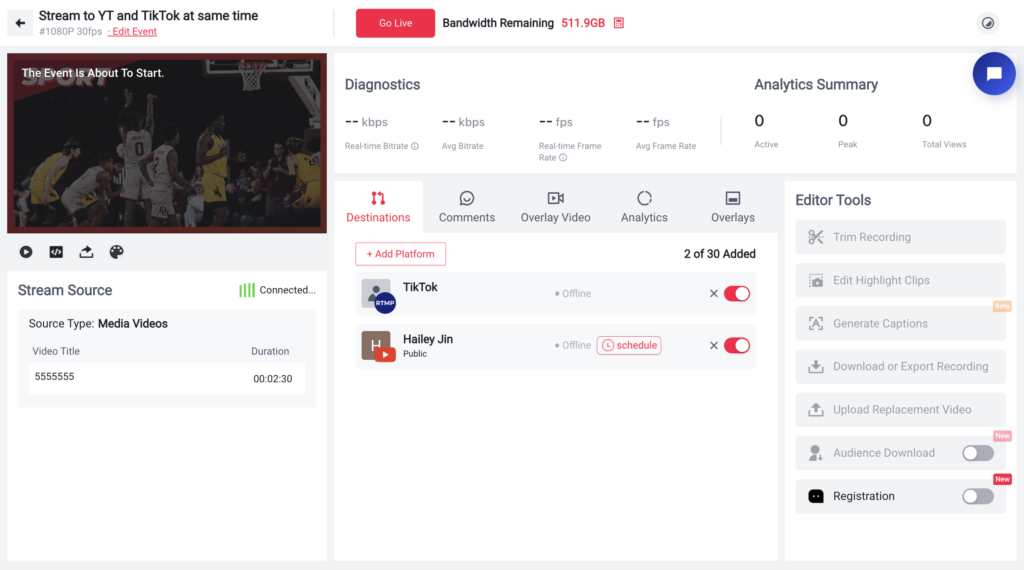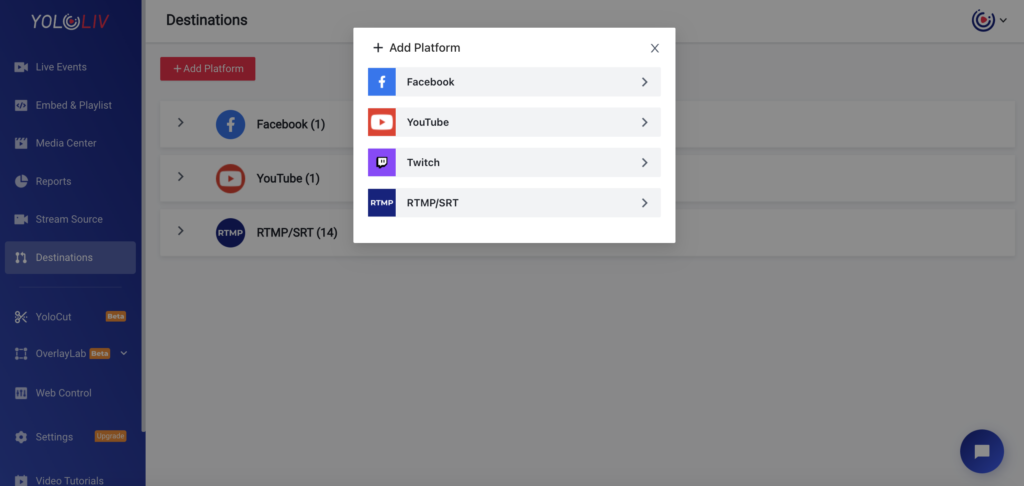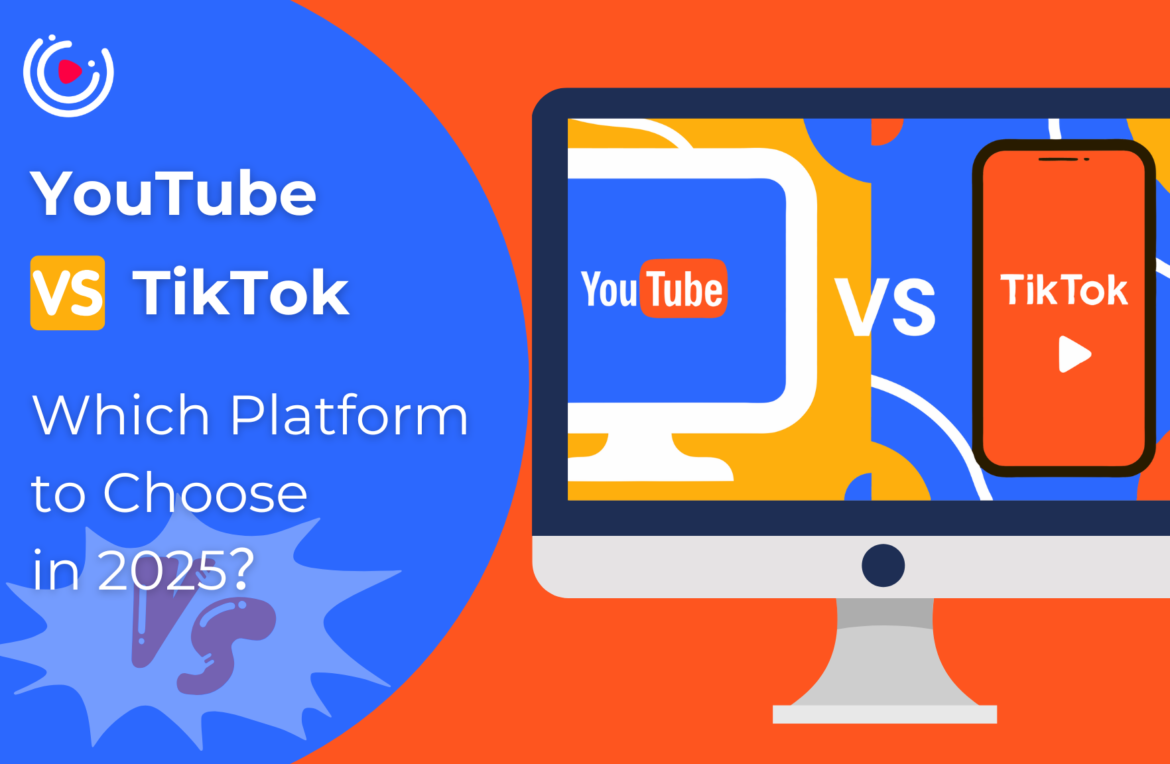It’s 2025, and if you’re a content creator or brand trying to decide between TikTok and YouTube, you’re not alone. These two giants have become the go-to platforms for everything from viral dances to in-depth tutorials. But each serves different audiences, formats, and goals. Whether you’re a hobbyist or an aspiring full-time creator, choosing the right platform can impact your growth, engagement, and monetization opportunities. So, how do you decide between the two? Let’s break it all down.
TikTok vs. YouTube
Audience & Reach
TikTok and YouTube serve massive—but very different—audiences.
TikTok has become the hub for Gen Z and younger Millennials who thrive on quick, snackable content. Its algorithm is scarily good at delivering exactly what you didn’t know you wanted, keeping users scrolling for hours. TikTok’s global monthly users have surpassed 1.5 billion, with a heavy concentration in the 18–34 age bracket. The platform thrives on trends, viral sounds, and niche communities that form around hashtags and challenges.
YouTube, meanwhile, remains the internet’s largest video platform with over 2.7 billion logged-in users every month. Its demographic is broader—ranging from teens to retirees—thanks to its vast library of content that includes everything from cartoons and music videos to educational content and long-form podcasts. YouTube is the go-to platform for anyone searching “how-to” anything. If your target audience includes older millennials or professionals, YouTube might be more aligned with your goals.
Content Format & Engagement Style
When it comes to format, the two platforms couldn’t be more different.
TikTok is designed for short-form, vertical video—usually 15 seconds to 3 minutes in length. The platform prioritizes high-energy, visually engaging content that can be consumed instantly. This creates a high-burst engagement style, where videos can rack up thousands of views in minutes but fade just as quickly.
YouTube, on the other hand, supports longer-form content—ranging from 5 minutes to several hours. Horizontal videos are the norm, and the content often includes deeper storytelling, educational insights, or serialized entertainment. This allows creators to build stronger viewer loyalty and long-term watch time. Engagement comes in the form of likes, comments, shares, and channel subscriptions, which help cultivate a community over time.
Monetization & Creator Tools
If monetization is your priority, both platforms offer robust but very different opportunities.
YouTube leads in creator monetization, offering multiple streams such as:
- Ad revenue via the YouTube Partner Program
- Channel memberships
- Super Chats in live streams
- Affiliate marketing and brand partnerships
- YouTube Premium revenue
The platform’s tools for analytics, content scheduling, and SEO optimization are also more advanced. You can optimize your content for search and build evergreen videos that generate income over months or years.
TikTok, while still catching up, is rapidly evolving. It offers:
- TikTok Creator Fund
- TikTok Series (a pay-to-view content model)
- Live gifting and tips
- Brand sponsorships
TikTok’s monetization tends to favor viral creators or influencers with niche authority. While the payout per view is often lower than YouTube’s, the quick viral nature can still turn a side hustle into a full-time gig quickly if you hit the algorithm jackpot.
Discoverability & Audience Growth
TikTok is hands-down one of the best platforms for instant discoverability. Thanks to its “For You Page,” new creators can go viral overnight—even with zero followers. The platform is optimized for exploration, meaning your content can land in front of new audiences almost instantly.
YouTube, however, favors consistency and SEO. Audience growth here is more gradual, driven by search, suggested videos, and channel subscriptions. While it takes longer to gain momentum, once you do, the results are often more stable and rewarding over the long term.
So, if you’re looking for a quick win, TikTok is the place. But if you’re playing the long game, YouTube may be the better bet.
Benefits of Streaming on YouTube
Streaming on YouTube offers creators a full suite of benefits that make it ideal for professional or long-form content creators:
- High-Quality Video Support: YouTube supports HD and even 4K resolution, making it a go-to for gamers, educators, and filmmakers.
- Monetization During Streams: With features like Super Chat, Super Stickers, and ads during streams, creators can earn in real-time.
- Wider Reach for Niche Audiences: YouTube’s algorithm and search function make it easier for users to find content relevant to their interests, even for smaller or niche topics.
- Better Analytics: YouTube Studio provides in-depth performance data to help you refine and grow your channel.
- Replay Value: Your streams can be saved as videos on your channel, gaining views long after the stream ends.
This makes YouTube the top choice for creators looking to build a comprehensive video library and monetize every piece of content strategically.
Benefits of Streaming on TikTok
While TikTok is traditionally known for short videos, its LIVE feature is gaining serious traction—especially among creators with an active follower base.
Here’s why you might consider streaming on TikTok:
- More Personal Engagement: TikTok LIVE feels like a real-time FaceTime with your audience. The format is informal, raw, and perfect for casual chats or behind-the-scenes looks.
- Built-In Interactivity: Features like live comments, polls, and gifting make TikTok streaming highly interactive and rewarding.
- Exposure Boost: Going live can boost your profile’s visibility. The TikTok algorithm often pushes live sessions to new audiences.
- Monetization Opportunities: Viewers can send you coins or gifts during a stream, which translates into real earnings.
TikTok LIVE is ideal for creators who love spontaneous, fast-paced interaction and thrive on trend-driven content.
How to Choose the Right Platform for You
Deciding between TikTok and YouTube in 2025 isn’t just a matter of where the trends are—it’s about aligning your content style, audience goals, and personal preferences.
Let’s break down the decision-making process:
1. Think About What You Love to Create
Are you someone who enjoys shooting quick, catchy clips and jumping on the latest trend? Do you thrive in a fast-paced environment with instant feedback? If that sounds like you, TikTok might be your playground.
TikTok is ideal for creators who:
- Love short-form, high-energy videos
- Want to hop on trends quickly
- Enjoy real-time reactions and viral potential
- Prefer informal, off-the-cuff content
But if you enjoy digging deep into a topic, storytelling, or producing polished, informative videos, YouTube offers a more structured platform with room for creativity and longevity.
YouTube is great for creators who:
- Enjoy longer-form content like tutorials, explainers, or vlogs
- Want to build a branded channel with playlists and series
- Value SEO and searchable content
- Seek multiple monetization methods
2. Know Your Audience
Who are you trying to reach? Your ideal viewer’s age, interests, and content consumption habits play a huge role in your platform choice.
- If your audience is younger (teens to early 30s), TikTok’s viral culture and short attention spans match well.
- If your target demographic includes professionals, parents, or knowledge-seekers, YouTube is the place they’re likely spending more time.
3. Consider Your Long-Term Goals
TikTok is perfect for quick hits of fame. But remember, virality can be fleeting. YouTube offers more control over your content, with potential for passive income from old videos and a steady stream of viewers from search traffic.
Ask yourself:
- Are you in it for quick brand exposure or a long-term career?
- Do you want a stable subscriber base or flexible viral potential?
- Are you looking to establish authority in a niche?
4. Evaluate Your Tools and Workflow
Your existing gear and workflow matter, too. YouTube typically requires more production effort—editing, scripting, thumbnails, SEO optimization. TikTok’s creation process is simpler and often happens directly in-app.
If you’re short on time or resources, TikTok’s minimal production requirements can be a win. But if you’re ready to invest in high-quality content, YouTube has the infrastructure to support it.
Can You Stream on TikTok and YouTube at the Same Time?
You bet you can. In fact, in 2025, it’s not only possible—it’s a smart move. Why limit yourself to just one audience when you can reach both TikTok and YouTube viewers at the same time?
This is where YoloCast comes in.
YoloCast makes it incredibly easy to multi-stream to multiple platforms simultaneously, including TikTok and YouTube. With just a single setup, you can go live and engage both your short-form-loving TikTok audience and your long-form YouTube fans—all in real time. Whether you’re running a product demo, live Q&A, or behind-the-scenes content, you no longer have to choose a side. You can simply stream once and broadcast everywhere.
However, there’s one important detail to keep in mind: video orientation matters. YouTube is built for horizontal (16:9) video, while TikTok thrives on vertical (9:16) content. YoloCast doesn’t automatically convert between formats—so the direction of your stream depends entirely on your camera source. If you go live with a horizontal setup, TikTok will still display your stream, but you’ll notice black bars at the top and bottom. Thankfully, TikTok auto-centers the video feed and doesn’t crop the edges, so your content still looks clean and professional.
The bottom line? Streaming to both platforms at once is not only doable, it’s a game-changer. Just make sure to plan your camera orientation ahead of time and optimize your layout for both formats. With YoloCast handling the heavy lifting, you can focus on what you do best—creating engaging, high-quality content for a growing audience across platforms.

How to Stream to YouTube and TikTok Simultaneously with YoloCast
1. Log into YoloCast
Start by logging into your YoloCast account.
If you don’t have one yet, click “Sign Up” and create an account—it only takes a minute. Even better, YoloCast offers a 14-day free trial, so you can test multi-streaming before making any commitments.
2. Add YouTube and TikTok as Destinations
Once you’re inside the dashboard, head to the Destinations. This is where you’ll link your streaming platforms.
- To add YouTube:
Click “Add Platform”, select YouTube, and follow the on-screen steps to authorize and connect your YouTube account. - To add TikTok:
Since TikTok doesn’t support direct platform integration yet, you’ll need to use RTMP. But don’t worry—it’s easy. First, check if your TikTok account is eligible for livestreaming. You’ll need to:- Be 18 years or olderHave at least 1,000 followersBe in good standing with the TikTok community guidelines

Once you’ve added both YouTube and TikTok, you’ll be able to select them as destinations every time you create a new livestream event in YoloCast. With a single broadcast, your stream will go live to both platforms—seamlessly.
Note: As always, pay attention to your video orientation. YoloCast doesn’t auto-adjust between vertical (TikTok) and horizontal (YouTube) layouts, so your camera source will determine how the stream appears. Streaming in horizontal? TikTok will center the video with padding above and below—no cropping necessary. But for best results, consider your framing and keep important visuals in the center.
Conclusion
So, TikTok or YouTube? The answer really depends on you.
If you’re a trend-hopper, meme-maker, or short-form wizard, TikTok will feel like home. If you’re a deep diver, teacher, or filmmaker at heart, YouTube is your creative playground. Each platform has its strengths and limitations—but with tools like YoloCast, you don’t have to settle for just one.
The real win? Creating content that you love, for the audience that loves you back—wherever they are.
26,108 total views, 179 views today

Hailey, a Customer Success Specialist at Yololiv, she brings immense enthusiasm to assisting users in understanding the various features of YoloCast and resolving any usage-related issues they may encounter. Alongside her support efforts, she also curates articles sharing tips, troubleshooting advice, and other helpful insights to enhance users’ experience with YoloCast.


